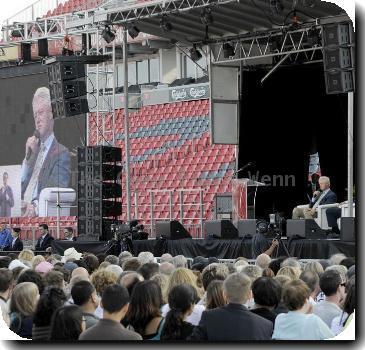Crews find sediment in Gulf relief well, delaying effort to stop gusher for good
By Greg Bluestein, APFriday, July 30, 2010
Effort to stop Gulf gusher delayed over sediment
NEW ORLEANS — The government’s point man for the Gulf oil spill says there’s been a delay in a procedure that will help stop the gusher for good.
Coast Guard Adm. Thad Allen said Friday that debris was found in the bottom of the relief well that must be fished out before crews can pump mud into the busted well in a procedure known as a static kill.
The sediment settled there last week when crews popped in a plug to keep the well safe ahead of Tropical Storm Bonnie.
They found it as they were preparing for the static kill and now they have to remove it. They had hoped to start the static kill as early as Sunday, but removing debris will take 24 to 36 hours.
After the static kill comes the bottom kill, where the relief well will be used to pump in mud and cement from the bottom.
THIS IS A BREAKING NEWS UPDATE. Check back soon for further information. AP’s earlier story is below.
BILOXI, Miss. (AP) — BP’s incoming CEO said Friday that it’s time for a “scaleback” of the massive effort to clean up the Gulf of Mexico oil spill, but he added that the commitment to make things right is the same as ever.
Tens of thousands of people — many of them idled fishermen — have been involved in the cleanup, but more than two weeks after the leak was stopped there is relatively little oil on the surface, leaving less work for oil skimmers to do.
Bob Dudley, who heads BP’s oil spill recovery and will take over as CEO in October, said it’s “not too soon for a scaleback” in the cleanup, and in areas where there is no oil, “you probably don’t need to see people in hazmat suits on the beach.”
He added, however, that there is “no pullback” in BP’s commitment to clean up the spill. Dudley was in Biloxi to announce that former Federal Emergency Management Agency chief James Lee Witt will be supporting BP’s Gulf restoration work.
With the northern Gulf of Mexico largely off-limits to fishing, BP’s cleanup program has been the only thing keeping many fishermen working. Losing those jobs would make the region all the more dependent on the checks BP has been writing to compensate fishermen and others who have lost income because of BP’s offshore oil spill, the worst in U.S. history.
Many people have complained about long waits and other problems in processing claims, and Dudley conceded that BP lacks expertise in handling claims. He said the company hopes to turn that work over to an independent administrator soon.
“It’s because of that lack of competence on our part … that we want to bring in a professional,” Dudley said.
Suggestions that the environmental effects of the spill have been overblown have increased as oil has disappeared from the water’s surface, though how much of the oil remains underwater is a mystery. Dudley rejected efforts to downplay the spill’s impact, saying, “Anyone who thinks this wasn’t a catastrophe must be far away from it.”
BP is hiring Witt, FEMA director under President Bill Clinton, and his public safety and crisis management consulting firm. BP did not say how much Witt would be paid.
Witt said he wants to set up teams along the Gulf to work with BP to address long-term restoration and people’s needs.
“Our hope is that we can do it as fast as we can,” Witt said. “I’ve seen the anguish and the pain that people have suffered after disaster events. i have seen communities come back better than before.”
The gusher set off by an April 20 oil rig explosion spewed between 94 million gallons and 184 million gallons into the Gulf before a temporary cap stopped the flow July 15.
A procedure intended to ease the job of plugging the blown-out well for good could start as early as the weekend, according to Retired Coast Guard Adm. Thad Allen, the government’s oil-spill response chief. The so-called static kill can begin when crews finish work drilling the relief well 50 miles offshore that is needed for a permanent fix.
The static kill, which involves pumping heavy mud into the busted well from the top, is on track for completion some time next week. Then comes the bottom kill, where the relief well will be used to pump in mud and cement from the bottom; that process will take days or weeks, depending on the effectiveness of the static kill.
Tags: Accidents, Bill Clinton, Biloxi, Emergency Management, Environmental Concerns, Louisiana, Mississippi, New Orleans, North America, United States

